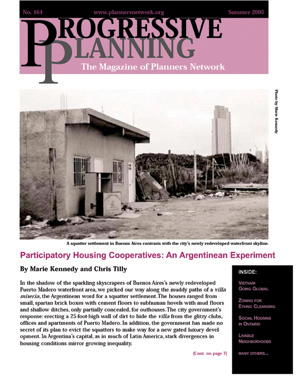By Tom Angotti
In the Jan/Feb 1998 issue of the Planners Network newsletter (the forerunner ofProgressive Planning Magazine ), I wrote, “If you love livable cities, hurry up to Hanoi ” because new development “threatens the city’s greatest asset, its street life.” Unfortunately, it’s now too late.
I recently spent three weeks in Hanoi studying the region and planning. As Vietnam ‘s economic czars race to catch up with China, they are creating gaping inequalities that the old planning apparatus is hard-pressed to deal with. The new entrepreneurial class is building wealthy enclaves all around the region, including gated communities where houses sell at prices comparable to Boston or San Francisco. Poor people are being moved out of old urban neighborhoods that are replaced by mammoth superblocks of commercial space and luxury housing. Peasants are leaving farms and artesancommunities to work in new urban industries and commerce, where they encounter unsanitary, crowded living conditions, high rents and, all too frequently, unemployment. Such a pattern is familiar in less developed countries, but Vietnam ‘s socialist orientation had previously excluded such excesses of capitalist urbanization.
Ciputra Hanoi International City is a giant new gated community going up in the fashionable West Lake neighborhood of Hanoi. An Indonesian investor bought from the government the right to build on land that was being used to grow flowers. He then fleeced individuals in the new cash-laden Vietnamese elite and expanding expatriate community to pay for their houses up front. Many of them bought with expectations of speculative windfalls, not out of a need for a place to live.
Ciputra’s landed gentry will enter their new community through a giant Baroque arch, where they may muse upon the glorious days of French colonialism. They can park their SUVs in the driveways of their Greek Revival mini-mansions, where they will forget the discomforts of the overcrowded, noisy, polluted city. They can send their children to the nearby International School, where they receive instruction in English, and drive to Ciputra’s mall for everyday Gucci goods. Ciputra’s architects may well have seen pictures of new urbanist experiments, for they included sidewalks, should any one dare to walk, and a few Asian design signatures.
The Revolution is Over, the Fight Begins
I opposed the Vietnam war (for the Vietnamese it was the American war) and, like many others who did so, I have always been reluctant to criticize the revolutionary movement and leadership that sacrificed so much to end the occupation by the most powerful military in the world and establish an independent nation. Millions of Vietnamese died, many of them civilians, in the bombings and “search and destroy” missions of the US military; from land mines and Agent Orange (a chemical weapon made in the US); and from the program of forced urbanization that produced concentration camps known as “strategic hamlets.” After the war, the Vietnamese followed the path set out by Ho Chi Minh, who founded the Republic in 1945 to rebuild Vietnam along socialist lines.
But Uncle Ho’s generation is mostly gone now, and the young generations have no memory of the war and a new set of aspirations. The collapse of the Soviet Union and the inability of Vietnam ‘s economy and institutions to address these aspirations led to a dramatic opening up to the global capitalist economy in 1993. In a scenario all too familiar elsewhere, Vietnam ‘s planning institutions caved under the influence of massive investments from Hong Kong, Singapore, Japan, Europe and the United States. Investors got cheap land and labor in industrial parks located along the highways the government built and maintained. International lenders rushed in to back the construction of a new urban infrastructure to support new development. In this climate, master plans follow the growth instead of leading it. Government and party leaders make the deals and prime the growth machine with huge infrastructure projects. Environmental impact statements are de rigeur, but government has little ability to enforce the rules or plan for long-term environmental quality. A giant informal economy has grown right along with the new industrial economy, and Vietnam ‘s economic planners are increasingly unable or unwilling to deal with it as long as the global marketplace benefits from it. Urban planning in Vietnam is becoming as irrelevant as it is everywhere that rapid “free market” growth is idolized and economic and physical planning are divorced from each other.
Government and party leaders, alarmed by the social and environmental consequences of the new capitalist bloom, call for balance and pass laws. The World Bank talks about “poverty reduction” and sustainable cities. But Vietnam ‘s “market socialism” seems to be mostly free-market capitalism; it is creating structural poverty, segregated cities and environmental destruction. The historic balance between agriculture, industry and urban life is being destroyed. A rich street life is being wiped out by the car and motorbike industries. Perhaps the best hope is in the scores of spontaneous protests against massive urban renewal and displacement which, for the moment, tend to be settled with bigger relocation benefits; the wildcat strikes against sweatshop conditions; and above all the men and women of the new generation who realize that quality of life can’t be bought from transnational corporations. Hopefully progressive Vietnamese will join the twenty-first century search for an alternative to global capitalism now that their government leaders have embraced it.
